
by Marie O’Mahony
Smart textiles are having an increasing impact on medical textiles. In a presentation at IFAI EXPO 2021, Carsten Linti from the German Institutes of Textile and Fiber Research (DITF) outlined some of the institute’s R & D in this field. DITF works with more than 1,200 enterprises, 78 percent of which are small-and-medium-sized operations.
Developments in medical textiles range from wound care and tubular trachea implants, to carrier materials for drug delivery and tissue engineering, but smart textiles are proving particularly effective as diagnostic systems. As e-textiles are able to cover most of the human body, access to a range of biosignals and interaction through an array of form factors is possible, providing a continuous and minimally obtrusive connection between the human body and the digital world.
The integration into leggings of sensors for EMG monitoring of muscle fatigue eliminates the need for wetting or adhesive attachments to the body making them more comfortable. This is particularly important when they need to be worn over a longer time period. Because they are easy to position with no wires or sensor nodes, wearers can fit the garments with sensors themselves, making it well suited for rehabilitation and sports training. Data is communicated to a smart phone with a shift of the median frequency indicating muscle fatigue.
In a second example, presenters described a sensory stocking that’s being developed to prevent pressure ulcers in diabetic patients. Strategically positioned sensors are located under the foot and at the side, ensuring no cross-influence of the pressure points, and allowing front and rear loads in each foot to be differentiated and clearly read.
In another sensor development, a runner’s acceleration and rotation are monitored in order to prevent injury and improve performance. This technology has been commercialized as “SensoRun,” a daily running analysis system.
The knee and shin strap sensors monitor both the knee and ankle, sending 256 measurements per second via Bluetooth, linked in real time to a Smartphone app. The wearer can use the device to check their movement, making improvements and helping to prevent strain injury.
Common to each of these developments is that they provide solutions to real, existing problems. This is an indication of the ability of smart textiles applications to address current market needs.
Dr. Marie O’Mahony is an industry consultant, author and academic. She the author of several books on advanced and smart textiles published by Thames and Hudson and Visiting Professor at the Royal College of Art (RCA), London.
 TEXTILES.ORG
TEXTILES.ORG


